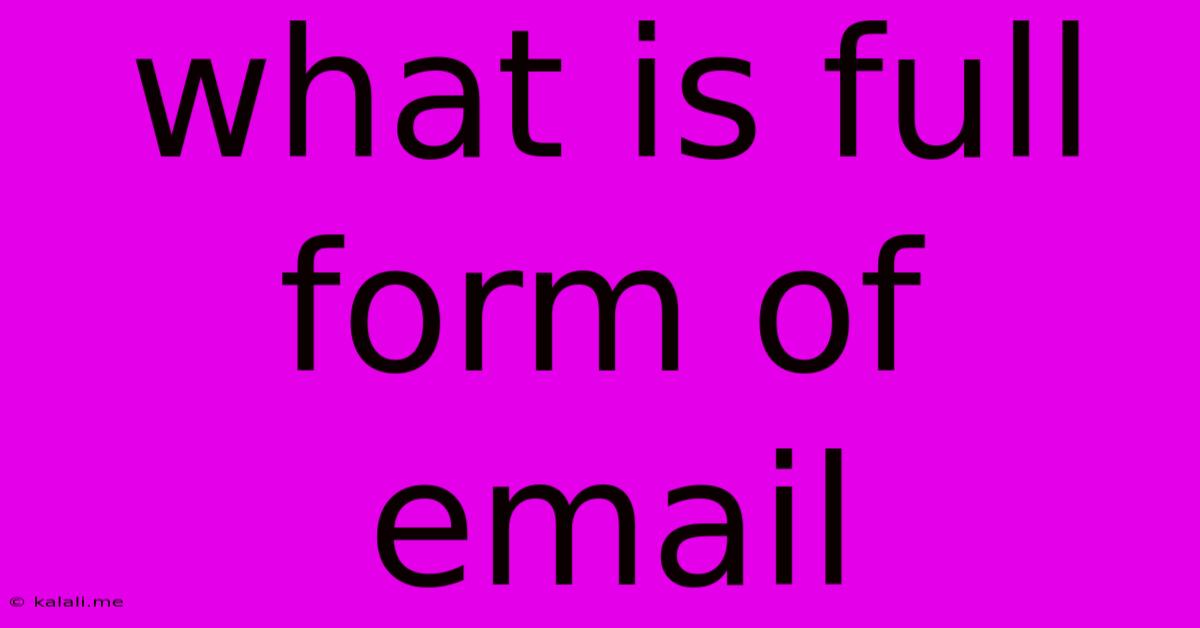What Is Full Form Of Email
Kalali
Jun 13, 2025 · 3 min read

Table of Contents
What is the Full Form of Email? Understanding Electronic Mail
So, you're curious about the full form of email? It's a question many people ask, and the answer is simpler than you might think. The full form of email is electronic mail. This simple phrase perfectly encapsulates the core function of email: sending messages electronically. This article will delve deeper into the history, functionality, and continued relevance of this ubiquitous communication tool.
While the full form is straightforward, the impact of email is anything but. It's revolutionized communication, impacting both personal and professional lives significantly. It's a cornerstone of modern communication, used for everything from casual chats to critical business transactions.
A Brief History of Email: From Arpanet to Inbox Zero
The origins of email can be traced back to the early days of the ARPANET (Advanced Research Projects Agency Network), a precursor to the internet. Early email systems were text-based and far less sophisticated than the email clients we use today. However, they laid the groundwork for the global communication network we rely on today.
The evolution of email has been dramatic. We've seen the rise of graphical user interfaces (GUIs), the incorporation of attachments, spam filters, and a vast array of features designed to improve efficiency and security.
How Email Works: A Simplified Explanation
At its core, email relies on a simple client-server model. When you compose and send an email, your email client (like Gmail, Outlook, or Yahoo Mail) interacts with a mail server. The mail server then transmits the email message to the recipient's mail server, where it's stored until the recipient retrieves it using their own email client. This process involves several protocols, such as SMTP (Simple Mail Transfer Protocol) for sending and POP3/IMAP (Post Office Protocol 3/Internet Message Access Protocol) for receiving.
The Enduring Relevance of Email in the Digital Age
Despite the rise of instant messaging apps and social media platforms, email remains a critical communication tool. Its advantages include:
- Formal Communication: Email provides a more formal and professional tone compared to instant messaging, making it suitable for official communications and business transactions.
- Record Keeping: Emails provide a written record of communication, invaluable for tracking progress, resolving disputes, and maintaining documentation.
- Broad Reach: Email allows you to communicate with individuals across geographical boundaries and time zones.
- Attachment Capabilities: The ability to send attachments makes it easy to share documents, images, and other files.
- Filtering and Organization: Email clients offer powerful filtering and organizational tools, allowing users to manage their inbox effectively.
However, the use of email isn't without challenges. Spam, phishing scams, and the sheer volume of emails many users receive daily remain significant issues.
Tips for Effective Email Management
- Unsubscribe from unwanted emails.
- Utilize filters and folders to organize your inbox.
- Prioritize tasks and respond to emails promptly.
- Keep your subject lines clear and concise.
- Proofread your emails carefully before sending.
In conclusion, while the full form of email is simply electronic mail, its impact on communication and the broader digital landscape is profound and continues to evolve. Understanding its functionality and utilizing best practices for email management are essential skills in today's interconnected world.
Latest Posts
Latest Posts
-
What Is Difference Between Pound And Kg
Jun 14, 2025
-
Which Phase Of Mitosis Is The Longest
Jun 14, 2025
-
Which Hormone Is Not Produced By The Placenta
Jun 14, 2025
-
The Electrons Present In The Outermost Shell Are Called
Jun 14, 2025
-
A Bar Magnet Is Placed In A Uniform Magnetic Field
Jun 14, 2025
Related Post
Thank you for visiting our website which covers about What Is Full Form Of Email . We hope the information provided has been useful to you. Feel free to contact us if you have any questions or need further assistance. See you next time and don't miss to bookmark.